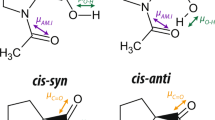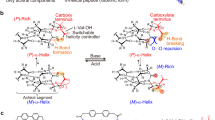Abstract
THE stability of the polypeptide chain of the α-helix has been extensively studied by both experimental and theoretical examination of the transition from the α-helical to random coil conformation of different homopolypeptides1,2. In these studies, the α-helix has been treated symmetrically along the helical axis. Amino acid residues located at the nth position from the N terminus and the C terminus of the α-helix in a homopolypeptide are assumed to behave in the same manner. However, the stability of the α-helix in the N-terminal region must be different from that in the C-terminal region, due to some extent to the asymmetrical nature of the peptide bond. It has not previously been known whether or not the influence of a polypeptide in random conformation is independent of the side of the α-helix to which the polypeptide is attached. We report here the first experimental evidence for such asymmetrical behaviour.
This is a preview of subscription content, access via your institution
Access options
Subscribe to this journal
Receive 51 print issues and online access
$199.00 per year
only $3.90 per issue
Buy this article
- Purchase on Springer Link
- Instant access to full article PDF
Prices may be subject to local taxes which are calculated during checkout
Similar content being viewed by others
References
Fasman, G. D. (ed.) Poly α-Amino Acids (Marcel Dekker, New York, 1967).
Poland, D. & Scheraga, H. A. Theory of Helix-Coil Transitions in Biopolymers (Academic, New York, 1970).
Takahashi, S. Bull. chem. Soc. Japan 50, 3344–3348 (1977).
Holzwarth, G. & Doty, P. J. Am. chem. Soc. 87, 218–228 (1965).
Parrish, Jr, J. R. & Blout, E. R. Biopolymers 11, 1001–1020 (1972).
Mattice, W. L. & Harrison, W. H. III Biopolymers 14, 2025–2033 (1975).
Kontani, T., Nishikawa, K., Iio, T., Takahashi, S. & Ooi, T. Bull. Inst. chem. Res. Kyoto Univ. 54, 128–140 (1976).
Nakata, Y., Akaike, T. & Inoue, S. Biopolymers 17, 937–942 (1978).
Kotelchuk, D. & Scheraga, H. A. Proc. natln. Acad. Sci. U.S.A. 61, 1163–1170 (1968).
Tanaka, S. & Scheraga, H. A. Macromolecules 9, 142–167 (1976).
Oobatake, M. & Ooi, T. J. theor. Biol. 67, 567–584 (1977).
Fredman, E., Gill, J. T. III & Doty, P. J. Am. chem. Soc. 83, 4050–4053 (1961).
Fajans, K. & Johnson, O. J. Am. chem. Soc. 64, 668–678 (1942).
Cohn, E. J. & Edsall, J. T. Proteins, Amino Acids and Peptides, 370 (Reinhold, New York, 1943).
Author information
Authors and Affiliations
Rights and permissions
About this article
Cite this article
TAKAHASHI, S., IHARA, S. & OOI, T. C-terminal side of α-helix is more stable than N-terminal side. Nature 276, 735–736 (1978). https://doi.org/10.1038/276735a0
Received:
Accepted:
Issue Date:
DOI: https://doi.org/10.1038/276735a0
Comments
By submitting a comment you agree to abide by our Terms and Community Guidelines. If you find something abusive or that does not comply with our terms or guidelines please flag it as inappropriate.



